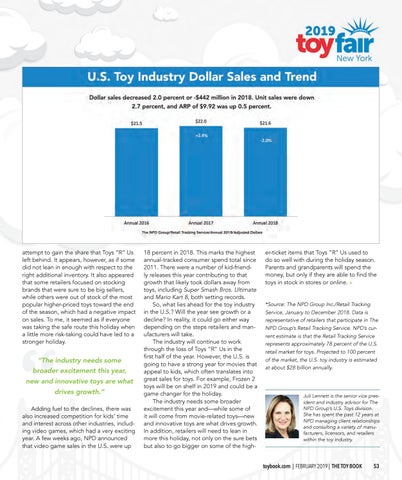attempt to gain the share that Toys “R” Us left behind. It appears, however, as if some did not lean in enough with respect to the right additional inventory. It also appeared that some retailers focused on stocking brands that were sure to be big sellers, while others were out of stock of the most popular higher-priced toys toward the end of the season, which had a negative impact on sales. To me, it seemed as if everyone was taking the safe route this holiday when a little more risk-taking could have led to a stronger holiday.
“The industry needs some broader excitement this year, new and innovative toys are what drives growth.” Adding fuel to the declines, there was also increased competition for kids’ time and interest across other industries, including video games, which had a very exciting year. A few weeks ago, NPD announced that video game sales in the U.S. were up
18 percent in 2018. This marks the highest annual-tracked consumer spend total since 2011. There were a number of kid-friendly releases this year contributing to that growth that likely took dollars away from toys, including Super Smash Bros. Ultimate and Mario Kart 8, both setting records. So, what lies ahead for the toy industry in the U.S.? Will the year see growth or a decline? In reality, it could go either way depending on the steps retailers and manufacturers will take. The industry will continue to work through the loss of Toys ”R” Us in the first half of the year. However, the U.S. is going to have a strong year for movies that appeal to kids, which often translates into great sales for toys. For example, Frozen 2 toys will be on shelf in 2019 and could be a game changer for the holiday. The industry needs some broader excitement this year and—while some of it will come from movie-related toys—new and innovative toys are what drives growth. In addition, retailers will need to lean in more this holiday, not only on the sure bets but also to go bigger on some of the high-
er-ticket items that Toys ”R” Us used to do so well with during the holiday season. Parents and grandparents will spend the money, but only if they are able to find the toys in stock in stores or online. » *Source: The NPD Group Inc./Retail Tracking Service, January to December 2018. Data is representative of retailers that participate in The NPD Group’s Retail Tracking Service. NPD’s current estimate is that the Retail Tracking Service represents approximately 78 percent of the U.S. retail market for toys. Projected to 100 percent of the market, the U.S. toy industry is estimated at about $28 billion annually.
Juli Lennett is the senior vice president and industry advisor for The NPD Group’s U.S. Toys division. She has spent the past 12 years at NPD managing client relationships and consulting a variety of manufacturers, licensors, and retailers within the toy industry.
toybook.com | FEBRUARY 2019 | THE TOY BOOK
53


